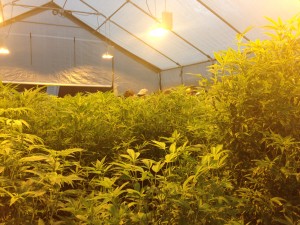
by Dominic Corva, Social Science Research Director
This may seem like an odd question, and it’s certainly not answerable given that we were never really able to tell what the environmental impact of cannabis prohibition was in Washington. However, we certainly can describe ground conditions set by Phase I of cannabis legalization here, roughly from December 2012-July 1, 2016 (when changes to I 502 from last year’s legislative session fully take over from I 502). Once we know these, we can begin to track the environmental impact of cannabis legalization going forward.
This post does not do that, although it is inspired by progress towards doing that in our forthcoming book, “Phase I of Cannabis Legalization in Washington State: An Ethnographic Report from the Field.” Instead, this post highlights our methodology for describing those ground conditions. It’s pretty simple.
First, we start with the BOTEC white paper from September, 2013, linked on the WSLCB web site, which identifies the main environmental impact policy concern: indoor production.
“We find that the predominant environmental concern in marijuana production is energy use for indoor production (less importantly for greenhouse production) and in particular the climate effects of this energy use. We then turn to the main opportunities for growers to reduce these environmental consequences, finding that the most important is substituting greenhouse and outdoor production for indoor operations, and managing indoor production for reduction of electricity use and especially electricity use during the day. We also sketch some ways the Liquor Control Board (LCB) can encourage better environmental practice in this industry (4 of 32).
If indoor production is “the predominant environmental concern in marijuana production,” then our methodology must be to identify how much of Washington’s production market created in Phase I is in fact indoor production vs greenhouse or outdoor.
One thing must be clear: this is not an indictment of indoor producers, some of which are subsidized for using LED lights; some of which are subsidized by local jurisdictions keen on re-industrializing a busted economy; and some of which intend to bootstrap into greenhouse production sometime in the future. As a result, this is not an indictment of WSLCB policies and rules. It is an objective assessment of the field given the analysis laid out by BOTEC’s WSLCB-endorsed white paper.
This is, therefore, a review of what happened in Phase I, in terms of what kind of cannabis production became possible at the very creation of our state’s legal market. It is subject to continual revision as Phase II develops.
At the moment, the actual data compiled by our sources is not ready for public consumption for a number of reasons. But here’s a rough sketch of what I see, for now.
- Washington State legal cannabis production is overwhelmingly indoor, driven especially by the development of highly capitalized warehouse operations especially on the West side of the state.
- Greenhouse production is minimal at best so far, but highly capitalized greenhouse operations on the East side of the state loom like expiration dates for Western warehouse production.
- Full sun outdoor production is, as you might expect, concentrated on the East side of the state. These operations are mostly devoid of Light Deprivation approaches, which means to me these operations are breathtakingly uninformed and shooting themselves in the foot every season that they delay implementing Light Deprivation crops — multiple ones, not just one.
- Indoor dominance in the first two years of production was pretty much sealed when the WSLCB failed to approve enough producers in the Spring of 2014, choosing instead to focus on approving Retail before swinging wildly back to producers in July 2014 — too late for any outdoor producers to get in a full season of experience and production.
- Thus, we are looking at only our second full season of outdoor and greenhouse production. It’s a massive ship to turn around, as indoor capacity has overwhelmed retail capacity by itself in the meantime; but it won’t take too many more full seasons before outdoor production overwhelms indoor production — not just with cheap “oil crops” and material for rolling joints, but boutique, indoor-competitive Light Dep product.
- And then there’s the pesticide phenomenon: is there an indoor-outdoor aspect to problematic pesticide use in Washington’s legal market?
I’m going to leave that last question dangling. But now you have an idea of how this particular question can be, and is being, answered.